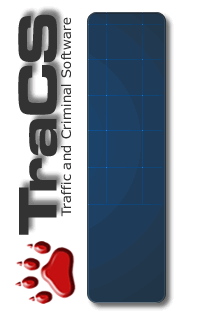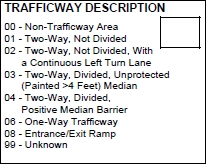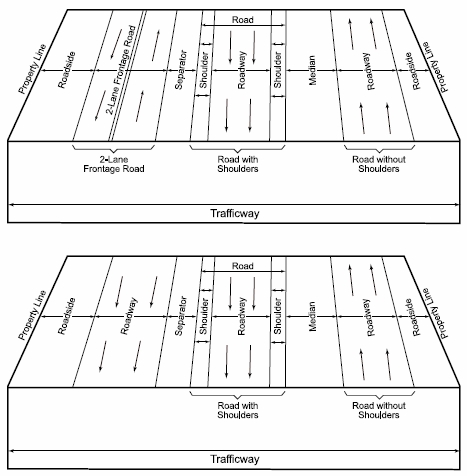

Select the trafficway flow just prior to this vehicle’s critical pre-crash event. A divided trafficway is one on which roadways for travel in opposite directions are physically separated by a median. See the following diagram:

For vehicles departing the trafficway prior to their critical pre-crash events, the trafficway selected for classification is the one the vehicle departed. If this vehicle is in a junction just prior to its critical pre-crash event, the trafficway selected is the one it is on before entering the junction.
00 - Non-Trafficway Area is used when this vehicle is entering a trafficway but was not on a trafficway prior to its critical pre-crash event.
A trafficway may include several roadways if it is a physically divided highway. Trafficways are not physically divided unless the divider is a median, barrier, or other constructed device. Pavement markings do qualify when they meet the definition of a median. Refer to the definition of 03 - On Median under the LOCATION OF FIRST HARMFUL EVENT RELATIVE TO TRAFFICWAY field.
A channelized lane should be considered a turn lane of the roadway it is part of, not a separate one-way roadway. Therefore, crashes occurring in a channelized lane should not be coded as a separate trafficway.
01 - Two-Way, Not Divided is used whenever there is no median. Generally, medians are not designed to legally carry traffic. NOTE: Although gores separate roadways, and traffic islands (associated with channels) separate travel lanes, neither is involved in the determination of trafficway division.
02 - Two-Way, Not Divided, With a Continuous Left Turn Lane is used whenever the trafficway has a two-way left turn lane positioned between opposing straight-through travel lanes. It is designed to allow left turns to driveways, shopping centers, businesses, etc., while at the same time providing a separation of opposing straight-through travel lanes.
03 - Two-Way, Divided, Unprotected (Painted over 4 Feet) Median is used whenever the trafficway is physically divided, however, the division is unprotected [e.g., vegetation, gravel, paved medians, trees, water, embankments and ravines that separate a trafficway (i.e., all non-manufactured barriers)]. NOTE: Raised curbed medians DO NOT constitute a positive barrier in and by themselves. The unprotected medians can be of any width, however, painted paved flush areas, must be at least 4 feet in width to constitute a median strip.
04 - Two-Way, Divided, Positive Median Barrier is used whenever the traffic is physically divided and the division is protected by any concrete, metal, or other type of longitudinal barrier (i.e., all manufactured barriers). NOTE: Raised curbed medians DO NOT constitute a positive barrier in and by themselves. For underpass support structures and bridge rails acting as a barrier, use this option.
Traffic Barrier refers to a physical structure such as a guardrail, a concrete safety barrier or a rock wall which has the primary function of preventing cross-median travel by deflecting and redirecting vehicles along the roadway on which they were traveling. Therefore, trees, curbing, rumble strips and drain depressions are not barriers.
All traffic barriers are constructed on a median strip; therefore, if a traffic barrier exists on a divided highway, 04 - Two-Way, Divided, Positive Median Barrier must be used. If it is not known whether or not a barrier exists, assume one does and use 04 - Two-Way, Divided, Positive Median Barrier (that is, if a median is known to exist).
06 - One-Way Trafficway is used whenever the trafficway is undivided and traffic flows one direction (e.g., one-way streets).
08 - Entrance/Exit Ramp is an auxiliary or connecting roadway used for entering or exiting through-traffic lanes of a limited access roadway.
99 - Unknown is used when the trafficway flow just prior to this vehicle’s critical pre-crash event is unknown.